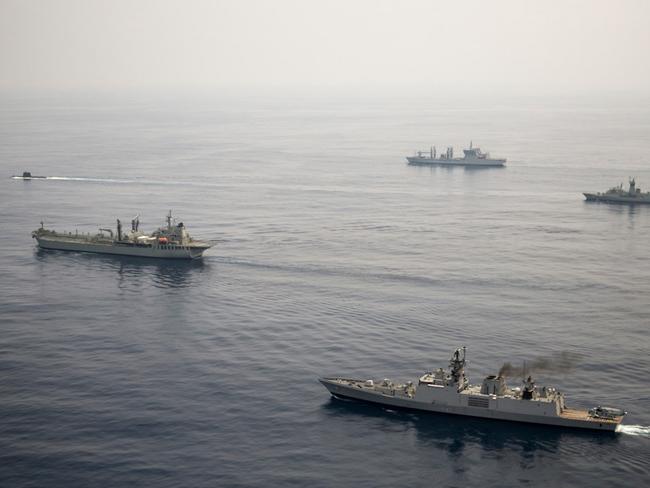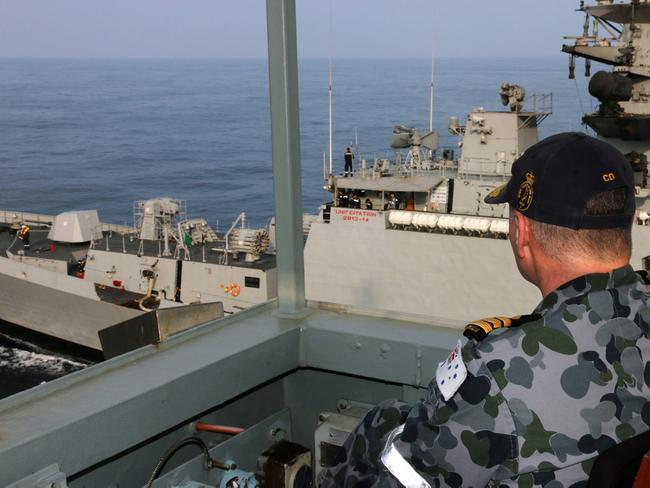Military superpowers are staking their claims on Australia’s doorstep
AS IF there weren’t enough military-related tension in the region already, another rising superpower is ready to test the limits of China’s patience.
ARE future superpowers already fighting over our doorstep? China is moving to secure its control over the narrow waterways of South-East Asia — and now India is following suit.
The United States and India have begun holding talks about conducting joint naval patrols that a US defence official told Reuters could include the disputed South China Sea.
It’s all part of a race to take up positions of power over arterial shipping lanes to Australia’s northwest. China is seeking to secure its interests, while the West — and India — aim at reinforcing their waning dominance.
.@USNavy #USSGonzalez conducts a live-fire exercise using an MK 45 5-inch gun in the #IndianOcean. @US5thFleet pic.twitter.com/aiBYiACNvs
— U.S. Dept of Defense (@DeptofDefense) February 14, 2016
Struggling sole-world superpower Washington is seeking to offload much of its international policeman burden — asking Asian allies to take a stand against China’s man-made islands in the Spratly archipelago. From this ‘great wall of sand’ China hopes to assert its will over a 3.5 million square kilometre expanse of natural resources and shipping lanes.
The Philippines, Malaysia, Thailand, Vietnam, Indonesia and Brunei all border this body of water and also lay claim to their own exclusive economic zones.
But China’s influence is already extending beyond its own backyard: It’s also making inroads into the Indian Ocean.
SCIO reports on ‘Belt and Road’ initiative https://t.co/jGbCF24Az0 pic.twitter.com/vksVebJUOt
— China SCIO (@chinascio) February 16, 2016
A surge of modern warships ships has been sent to the Indian Ocean by Beijing, with repeated forays by submarines adding to frayed nerves. This is all on top of the establishment of a Chinese naval base in north Africa.
Delhi has noticed.
As a result, non-aligned India and the United States have ramped up their military ties in recent months — holding naval exercises in the Indian Ocean that have included Japan.
Australia’s military has also woken up to the new kid on the block — choosing to attempt engage India through an unprecedented series of friendly naval exercises.

SUPERPOWERS ON THE RISE
Delhi has been steadily building up its military might in recent decades. It has been contributing towards the development a new stealth fighter in conjunction with Russia, the T-50 FGFA. INS Vikramaditya, a refurbished Russian aircraft carrier, will soon be joined by India’s own home-built INS Vikrant.
Now China’s growing interest in the Indian Ocean is making Delhi nervous.
India recently announced it was deploying its brand-new P-8 Poseidon maritime surveillance aircraft to the Andaman and Nicobar Islands overlooking the vital Malacca Strait choke-point between it and the South China Sea.
The move follows a major upgrade to India’s major naval base on Great Nicobar Island, and the deployment of its latest — and largest — aircraft carrier INS Vikramaditya to its eastern seaboard.
Chinese Type 054A frigates to attend Int'l Fleet Review in #Visakhapatnam, #India on Feb. 6 https://t.co/cw0W8aVZrU pic.twitter.com/mO386E3Rdd
— People's Daily,China (@PDChina) February 5, 2016
Such a ‘pivot’ by India’s military to the Bay of Bengal and Andaman Sea would give it similar dominance over vital shipping lanes as the artificial-island military bases do for Beijing in the South China Sea.
That leaves Singapore the meat in the sandwich.
Such a repositioning of its forces also enables Delhi to keep a close eye on China’s surface and submarine movements into the Indian Ocean.
This new posture has important implications for Australia, which has for decades held responsibility for policing the Malacca Strait shipping lane and its approaches.
Called “Operation Gateway”, Australia’s P-3 Orions took up the role in 1981 as a counter to what was then a surge of Soviet submarines into the area.

MUTUAL INTERESTS
The Indian navy has never carried out joint operational patrols with another country. A naval spokesman told Reuters there was as yet no change in its policy of only joining United Nations-sponsored international military efforts.
But, a year ago, US President Barack Obama and Indian Prime Minister Narendra Modi resolved to “identify specific areas for expanding maritime co-operation”. This included “ensuring freedom of navigation” in the nearby South China Sea.
The US defence official told Reuters the two sides had now discussed joint patrols, adding that both were hopeful of launching them ‘within the year’.
Such patrols would likely be in the Indian Ocean as well as the South China Sea, the US official told Reuters in New Delhi on condition of anonymity. The official gave no details on the scale of the proposed patrols.
#Video: Tanks, missiles, dogs, camels, motorcycle stunts, #India displays military might at #RepublicDayParade Tue. pic.twitter.com/3dSTnb96iH
— People's Daily,China (@PDChina) January 26, 2016
China accused Washington this month of seeking maritime hegemony in the name of freedom of navigation after a US Navy destroyer sailed within 12 nautical miles (22km) of a disputed island in the Paracel chain of the South China Sea in late January.
The US Navy conducted a similar exercise in October near one of China’s artificial islands in the Spratlys — sparking a war of words between Beijing and Washington.
Adding Delhi to the mix would be a significant ‘win’ for Washington’s bid for Asian nations to take up some of the diplomatic burden.
In the case of India, it may well be a case of tit-for-tat: Putting its military in waters significant to Beijing because Chinese ships have now begun paying regular visits to shipping routes important to Delhi.

CHINA FLEXES ITS MUSCLE
The People’s Liberation Army Navy has, since 2008, been sending its warships through the Malacca Strait to help police the Arabian Sea against piracy.
But recent deployments of conventionally-powered Chinese submarines in the area has raised fears of similar ‘shows of strength’ by nuclear-powered attack and ballistic missile submarines.
As a central part to just such an expansion of its military influence, China has already established an ‘overseas’ military base in Djibouti at a strategic ‘choke point’ between the Red Sea and Gulf of Aden, which divide Africa from the Middle East.
Naturally, Australia and India are worried about what this means for the balance of power in the Indian Ocean which has — up until now — largely been their own private lake.
Thus the new interest in establishing joint operations between Australian and Indian militaries, and the US seeking to do the same.
Talks are already underway with India for Australia and the US to share access to India’s new naval and air facilities being established on the Andaman Islands.



